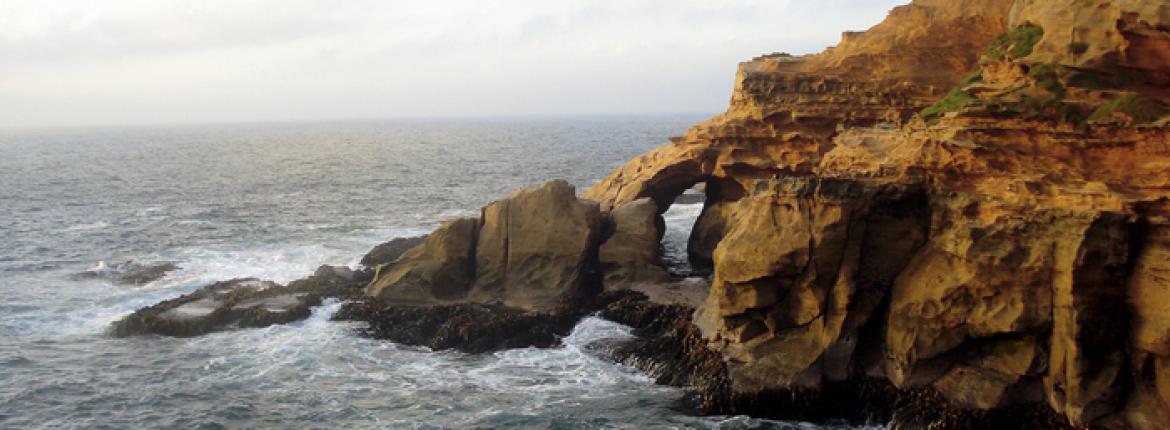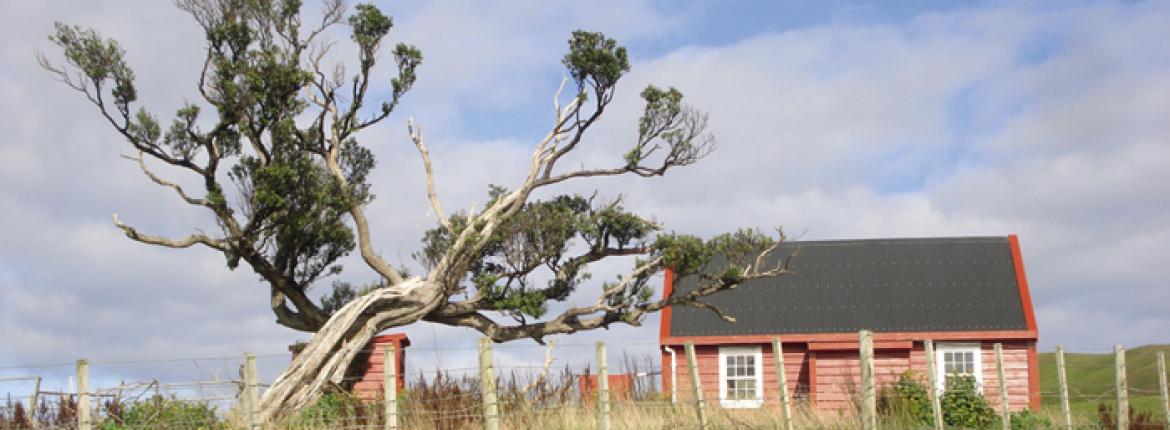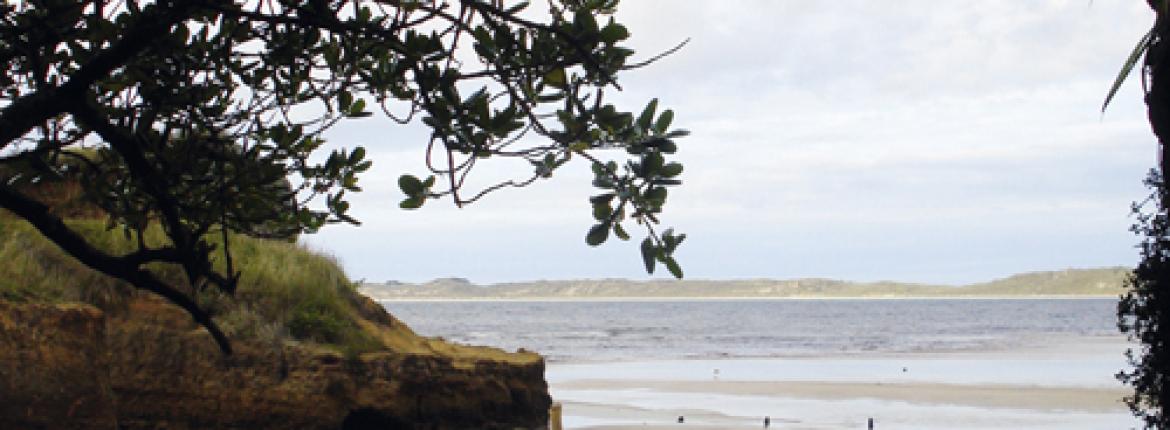You can tell a lot about an island just from the rubble at its edges.
From the beach, I step up to the Hotel Chatham and beyond to a grassy hill that leads to orange cliffs so enriched with sunlight they look like a National Geographic spread of the Grand Canyon. At the top of the cliffs I look into the delicate frills of a fossilised sponge, thrown up from the sea, edging towards the clouds, millennium by millennium, like a trembling geological tutu on a rocky stage. I turn back down the track. The dark seaweed swirls hypnotically, the icy-blue waves crash in deep narrow blowholes and I watch my footing. A tangi for a tourist is not an unknown event here.
These are the magic isles that enjoy ‘fine spells’ as a coda to the forecast for the benefit of their 600 inhabitants, as mainlanders turn their radio volumes down. “It will be freezing,” someone said before I left. And: “There are no cars”. But I swim three times on warm beaches, which I reach by vehicle.
Andy guides his tour bus deftly over the unsealed roads, neatly packed lunches rattling alongside the chess books he studies as he boils the billy. The Government affords the Chathams a mere kilometre or two of new tar-seal per year, so the sealed road extends like a black glacier. We pass gorse bushes and the famous wind-sculpted sideways ake-ake trees, as Andy spins yarns about everything in sight through the PA system, answering questions thrown up from behind him.
If you could see them from above, the Chatham Islands would look like an apple nibbled down each side, with a few dropped bits floating around the edges, leaving the core, holder of the seeds, which could bethe numerous black swans swimming in Te Whanga Lagoon.
We find black shark-tooth fossils amongst the kina spines at Blind Jim’s Creek; a seal colony; miniature bamboo species in a peat bog; Maori and Moriori art, including the enigmatic dendroglyphs (pictures on trees) in the kopi groves of Hapupu Reserve. Hexagonal basalt columns of cooled lava march up from the surging waters at Ohira Bay, forming a natural Grecian amphitheatre complete with the stray memento mori of a weathered goat carcass.
When the sun goes down and my fellow visitors have retreated to their hotel suites, the pub fills with deckhands and rousies. Up the road at Nadia’s house, Pita is smoking eels for tomorrow’s festival; the headlights catch them hanging eerily from the rafters of the shed. I am fooled into adhering to the ‘tradition’ of kissing an eel. There is a party nearby and everybody dances till some ridiculous hour and, in the morning, a kindly member of the tour group knocks on my hotel-room door as the bus is about to leave.
We go to the Chatham Island Wild Food and Music Festival, which features food plucked from land, sea and air, local arts and crafts, shearing competitions, eating competitions, and local musicians Off Da Cuff, as well as Anika Moa (I thought that was her on the plane), and FattyJay Murphy – who happily obliges me with a Bowie cover.
Swan pizza, whilst not about to appear on the board at Domino’s, would appeal to those who like jerky. Weka is even more gamey – yes, you are allowed to hunt and eat it here, despite the fact that Chatham Islanders self-identify as Weka, where mainlanders call themselves Kiwi. Pita’s richly smoked eel turns up (it is also his band playing – everybody has more than one role here), and gorse cake – a distinctive, wild, but not prickly experience.
 My favourite kai moana is the Hotel Chatham’s fish chowder and the paua wontons at the festival, crisp and yellow, soaking into the paper towel and reddening my fingertips with their heat, as I bite into the blue-black meat. It is the abundance of marine life that makes a living for so many Chatham Islanders, as vast quantities of it reappear on tables in China and America.
My favourite kai moana is the Hotel Chatham’s fish chowder and the paua wontons at the festival, crisp and yellow, soaking into the paper towel and reddening my fingertips with their heat, as I bite into the blue-black meat. It is the abundance of marine life that makes a living for so many Chatham Islanders, as vast quantities of it reappear on tables in China and America.
Another day, we are out on the ocean ourselves, boating along the wave tops on the Pitt Island day trip. Our hosts here are Brent and Bernie Mallinson of Flowerpot Bay Lodge, a luxurious house overlooking a secluded cove, which will be ready to receive guests early next year. This is the only other island in the Chathams inhabited by humans.
A tiny Chatham Island tomtit watches, as I open the gates for our van to pass through the farmland.
From Pitt we spot many other islands, including predator-free South East, or Rangatira Island, haven to the Chatham Island black robin and home of the fearsome weta-devouring Rangatira spider, of which even pig hunters are afraid.
Every so often, we are told, a human skull or an old tool falls out of a sandy cliff. Most of Pitt Island must be tapu in some way or other.
Through the mushroom-dotted pasture, feral geese accompany us towards a respectfully neatened patch of short grass on which stands the small white church of Our Lady of the Antipodes. Colourful Catholic icons create a feeling of the numinous inside, so far from Rome. Looking out through the window I see late blooms of yellow rautini: Chatham Island Christmas tree. Its botanical name is Brachyglottis huntii, after Frederick Hunt, the first European to make a go of life on Pitt, in 1843.
There is a school too, surprisingly well-resourced for six pupils, four of whom are the teacher’s own kids: plenty of books, a plant nursery and orchard, a pool, and a computer per child. Some of them are away riding on the annual Pitt Island cattle muster, which we get stuck behind on the trail back to the bay. I hop out of the van and wrangle a horse from an obliging owner; riding along amongst the whiskey-bottle-passing musterers is the highlight of my day.
Lending a visitor the horse he is sitting on is fairly typical of the Chatham Island bounteousness we meet at every step.
With the International Dateline bending around us, we are amongst the first humans to see the sunrise and it is this that tells us to start out and make the most of the day.
I remember how to walk slowly and study the horizon when I return to the city, where traffic lights tell you when to move, rather than the sun. Even though back here I have no hope of tripping over a lump of ambergris or a shipwreck full of crayfish, I still fancy myself 45 minutes ahead in time, hiking over dinosaur bones on the green volcanic peaks of the Land of the Lotus Eaters.
More information
- The Wild food and Music festival happens annually. Next year's festival is March 10
- Air Chathams flies from Auckland, Wellington, Christchurch and Napier several times a week, more often in summer
- The best time to travel is between October and April, but tours are available all year round. Seasonal varieties include fishing, diving, hunting, tramping, geology, ornithology, botany and painting tours
- For good old-fashioned hospitality, stay at the Hotel Chatham in Waitangi, with host Valentine Croon
- The writer travelled to the Chatham Islands on an escorted tour as a guest of Pukekohe Travel
Reported by Pippa Strom for our AA Directions Summer 2011 issue






